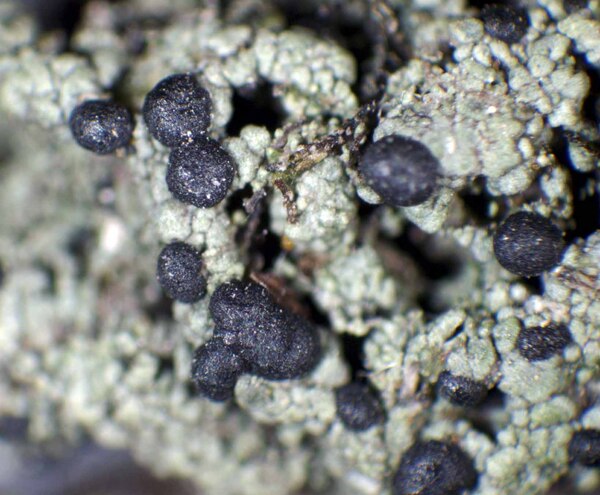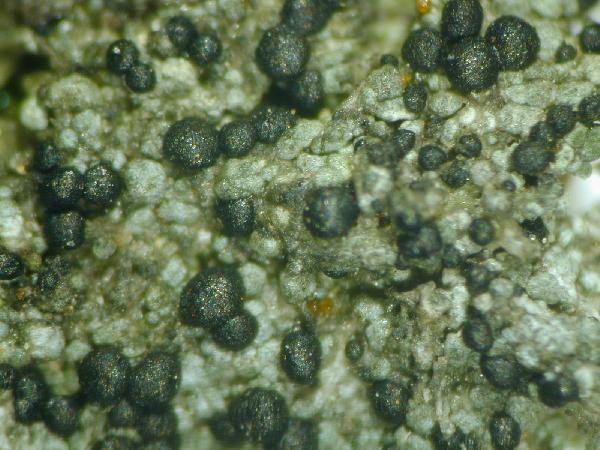Bilimbia accedens Arnold
Flora, 45: 391, 1862.
Synonyms: Bacidia accedens (Arnold) Lettau; Bacidia decedens (Stizenb.) Mig.; Mycobilimbia accedens (Arnold) V. Wirth ex Hafellner; Myxobilimbia accedens (Arnold) Hafellner
Distribution: N - VG (TSB 15457), Frl, TAA, Lomb (Ravera & al. 2022), Piem, Emil (Tretiach & al. 2008, Fariselli & al. 2020). C - Tosc (Jatta 1909-1911), Marc (TSB 24011), Abr (Jatta 1909-1911), Mol (Nimis & Tretiach 2004, Caporale & al. 2008). S - Camp (Nimis & Tretiach 2004), Bas (Jatta 1909-1911).
Description: Thallus crustose, episubstratic, whitish, farinose-granulose. Apothecia frequent, biatorine, sessile, 0.3-0.7(-0.8) mm across, with a blackish brown to black, initially flat, then rapidly convex disc, and a thin, soon excluded proper margin. Proper exciple well-developed, of stout, radiating hyphae in a gel matrix; epithecium bright to blackish emerald green or olive-green, K-; hymenium colourless, >60 µm high, I+ blue; paraphyses coherent, mostly simple, 2-3 μm thick at mid-level, the apical cells up to 5(-6) μm wide; hypothecium reddish brown at least in upper part. Asci 8-spored, cylindrical-clavate, with a K/I+ blue apical dome penetrated by a narrow, K/I– apical cushion surrounded by an indistinct, apically often tapering, wall K/I– but surrounded by an I+ red-brown, K/I+ blue outer layer. Ascospores (5-)7-9(-10)-septate, hyaline, ellipsoid-cylindrical, 20-45 x (5-)6-7(-9) µm. Photobiont chlorococcoid. Spot tests: thallus K-, C-, KC-, P-, UV-. Chemistry: without lichen substances.Note: on mosses overgrowing soil and rocks, with optimum on calciferous substrata in upland areas. Closely related to, and perhaps a synonym of Bilimbia sabuletorum. The record from Sicily (Nimis 1993: 442) was due to a misidentification. For synonymies see Ekman (1996).
Growth form: Crustose
Substrata: soil, terricolous mosses, and plant debris
Photobiont: green algae other than Trentepohlia
Reproductive strategy: mainly sexual
Commonnes-rarity: (info)
Alpine belt: rare
Subalpine belt: rare
Oromediterranean belt: absent
Montane belt: rare
Submediterranean belt: absent
Padanian area: absent
Humid submediterranean belt: absent
Humid mediterranean belt: absent
Dry mediterranean belt: absent

Predictive model
Herbarium samples
Growth form: Crustose
Substrata: soil, terricolous mosses, and plant debris
Photobiont: green algae other than Trentepohlia
Reproductive strategy: mainly sexual
Commonnes-rarity: (info)
Alpine belt: rare
Subalpine belt: rare
Oromediterranean belt: absent
Montane belt: rare
Submediterranean belt: absent
Padanian area: absent
Humid submediterranean belt: absent
Humid mediterranean belt: absent
Dry mediterranean belt: absent

Predictive model
| Herbarium samples |
 INDEX FUNGORUM
INDEX FUNGORUM
 GBIF
GBIF
 DOLICHENS
DOLICHENS





